On the relationship between vitality, activity, financial giving, and church budgets
There are two relatively well-understood phenomena in the culture of western protestantism that are often exclusively taken seriously among a small segment of professional church developers (senior clergy, consultants, philanthropic trusts, and financial organizations who pace capital loans to church metrics.)
The first is common knowledge but it represents a departure from norms at FSC so I won’t be pushing it in our context.
Mainline churches hire for the current needs of the church. Evangelical churches hire for the current vision of the church.
Many mainliners want to know “how the hell do these evangelical churches grow so fast?” Church growth isn’t so much a function of culture as it is a result of evangelism. (Let’s go ahead and retire that word because it has too much baggage. Let’s swap it out for something less loaded. We can talk about “hospitality” or “stickiness.”)
If a mainline church honestly wants to grow it will often focus on “telling its story” or employ various gimmicks to get people to invite their friends to church.
If an evangelical church wants to grow it will hire more clergy. That’s it, that’s the whole deal.
In most evangelical settings, clergy are required to grow the church. It’s not a “want” or a “request.” Failure to do this will result in the loss of a call. If this feels a bit like the culture of MLM cults, well, it is worth noting that Amway had its roots in the culture of the evangelical churches of the 1950s and 60s.
Evangelical churches grow by hiring more staff. If they have one pastor and 120 members and they would like to have 240 members they simply hire another pastor.
Mainline churches wait. They wait until there are twenty or so children and then they hire a school director. They wait until they have twenty or thirty special needs members and then they hire a parish associate. They wait until the 120 members are “giving until it hurts” and then they hire another pastor. They wait until the money is “in the bank” and then they make a hiring decision based on current available resources.
“We don’t have the money for a youth pastor!” is a phrase that you will not hear in an evangelical congregation. Most evangelicals will take it as a given that, “we don’t have a youth program because we don’t have a youth pastor.”
The second phenomena involves the speed at which giving intersects with growth.
Unfortunately I have to use the unsavory jargon of church growth, here, and talk about “giving units” because we haven’t come up with a better descriptor for “the unit that puts the pledge on the barrel.” FSC has a wild diversity of families. Many of our pledges come from a married couple. Some come from individuals who are married but one spouse has no affiliation with the church. Many are families. Many are families with two or even three last names.
Some of our pledges come from solo individuals, but a pledge is not a person - a pledge comes from group of people that ranges somewhere between 1 and 10.
Growth has a long tail. If I’m standing over a deep hole in the ground with a rope dangling over the edge, and I know that rope is tied to a bag of gold at the bottom of the hole, I’ll start hauling on that rope. An onlooker might see me sweating away, hauling on that rope, and ask, “what has hauling on the rope gotten you? There you are, hauling away, sweating through your clothes, and you’re no better off than when you started!”
This is factually correct.
This is not a helpful observation.
The gold is at the end of the rope. It doesn’t accrue while I’m hauling on the rope.
We are growing, and it will take time to turn this energy into pledges. Many of the new folks we’re bringing in through the doors will contribute to our congregation in countless ways that we can’t even envision. I have the terrible habit of failing to ask new people what they’d like to contribute when they sit in my office (I’m usually chasing after the thing that got them through the doors in the first place).
Look around at the deacons and elders of FSC. (Every church has deacons and elders, whether they admit it or not.) Someone with a similar skill-set likely walked through the doors of the church recently - but it may take them several years to find their niche in our ecosystem.
Likewise, most new members don’t have a clear picture of how they can best financially support their new church. In the case of FSC, many of our new members have never been a part of a healthy church community. They may have zero cultural affiliation with philanthropy and what is actually expected. Finally, they often prefer to give in different ways, with greater transparency - i.e. supporting the church through many smaller gifts rather than setting aside a lump-sum pledge for the year.
(As an aside, I want to remind all of us that millennials give more per capita than any other generation, adjusted for income. “In fact, they give more than twice as much of their money and time to charitable causes as either Baby Boomers or Gen X.”) Different generations give differently. Some prefer to give to very specific, defined causes. In church settings, many prefer to support individual programs while others wish to be asked only once per year.
We are in a situation where giving is up at FSC, and costs have also increased. We are still maintaining a razor-thin personnel budget (only budgeting to meet the current needs of the congregation, encouraging members to take on more and more of the labor of the church). But utility costs are up. Building operations costs are up.
This is a good sign.
When I arrived, the building was open “to the public” for roughly 12 hours a week. Tuesdays and Thursdays from 10a to 2p and Sunday mornings.
Today, it is wide open - hitting 60 to 70 hours of activity during some of the busier weeks. We’re seeing the building being deployed by the community in the way that was intended by your founders. The sanctuary, the Memorial Tower, these were intended to be public spaces, open to the public. Likewise the church house and classrooms were designed with an eye toward public use. Junior College (GRCC) held regular classes in the basement. All of those wondrous non-profit start-ups were fueled by public activity in the building (ACLU of WMI, Planned Parenthood, Americans for Separation of Church and State, etc.)
We could choose to do what Milton McGorrill did - we could try to squeeze rent checks out of these new friends. I’ve already explained why this would be a catastrophically bad idea. We’re already dealing with the fall-out from “tenant issues” in recent years.
Or, we could choose to support growth, invest in these new partners, and begin to adopt a posture that understands that the building will simply cost more to operate if we’re going to actually execute the mission of the church.
To make all of this as simple and straightforward as possible:
The building is doing what it was built to do.
It will take another year for congregational giving to fully catch-up.
With the support of the officers and the governing board, we’re going to approach a few of the committees of the church with a request to invest in the operations of the church. These gifts will help build a bridge in the budget between 2025 and 2026. They will be aligned with the goals of the committees.
Perhaps the Social Justice committee can make a grant to cover costs associated with the ground-breaking social justice work that is happening on campus - supporting organization that are right here in our building, offering us support, programming, activities, and raising public awareness about our campus.
Perhaps the Property committee can help offset the custodial costs associated with attracting events to our structure that will elevate the historic nature of our physical campus - sustaining and growing opportunities for pursuing outside grants for major building repairs while helping us make our building as welcoming as our people.
The various music funds could perhaps assist with offsetting the costs of music education programming that we provide to the greater community free of cost or at greatly reduced costs - in the full knowledge that the community will support and sustain these efforts by returning to us on Sunday morning and Thursday evenings.
In return, these committees will take credit for the increase in giving associated with these areas of our church life. As the budget increases, so will funding for the committees.
We need to find a way, together, to build bridges between our guests and our committees. I believe that engaging the committees in the operation of the building is the best path forward.
Kids at Church
The story of the relationship between Fountain Street Church and children, broadly speaking, is foundational to any understanding of the identity of the church. And this is both historically and contextually appropriate.
The story of Grand Rapids is, in many ways, a story about children. One of the first permanent structures erected by the white colonizers of the Grand River Valley, in 1834, was a school for children. The schoolhouse necessitated shuttling children across the river by canoe every day - and it was open to all children in the area. The St. John’s orphanage was one of the earliest structures erected by the Dominican sisters and Grand Rapids was viewed as a “haven” for children orphaned by the countless pandemics that ravaged the state.
I’m not going to write a history of the relationship between children and this city. Suffice to say that the care and love for children is deeply woven into the fabric of this place. The city has been home to one of the finest Children’s Museums in the nation and it’s lived around the corner from the church at 11 Sheldon Ave since 1994.
And, theologically speaking, FSC has always taken a progressive and somewhat child-like approach to religious practices and traditions. The church requires a childlike position toward pressing questions. We have no catechism or doctrine or creed with will to fill buckets. We have sparks, ideas, and endless curiosity. Endless experiments. Endless questions. Dogma closes the door on probing questions and asking “why?” There is precious little dogma at FSC and when we find it we subject it to a thorough inquisition, after which it often evaporates like a morning fog subjected to summer sunlight.
Various bits of scripture have been plucked out of context in order to give voice or authority to the practices and traditions at FSC - but I truly believe that Jesus’ philosophy toward the wisdom of children is a touchstone around here.
“Truly I tell you, unless you change and become like children, you will never enter the kingdom of heaven.”
Youth and children’s education has always been a part of your history.
Fountain Street Church has a few “groups” or “committees” that survived both the fire of 1917 and the despair of the late 1930s, two early 20th century events that nearly ended the congregation. These include the Women’s Association, the Great Speakers series, and the Fountain Club.
The Fountain Club had its genesis in 1927 and has remained steadfast to its remarkable, early values. It is a program that is open to all youths in the city regardless of their church affiliation. It is governed and directed by the youth. It represents itself to the rest of the congregation. It raises funds independently. These are the values of the organization when it is at its very best. (And we intend to lay the groundwork that will restore it to its very best.)
Behold! The Founding Moment of the great Fountain Club!

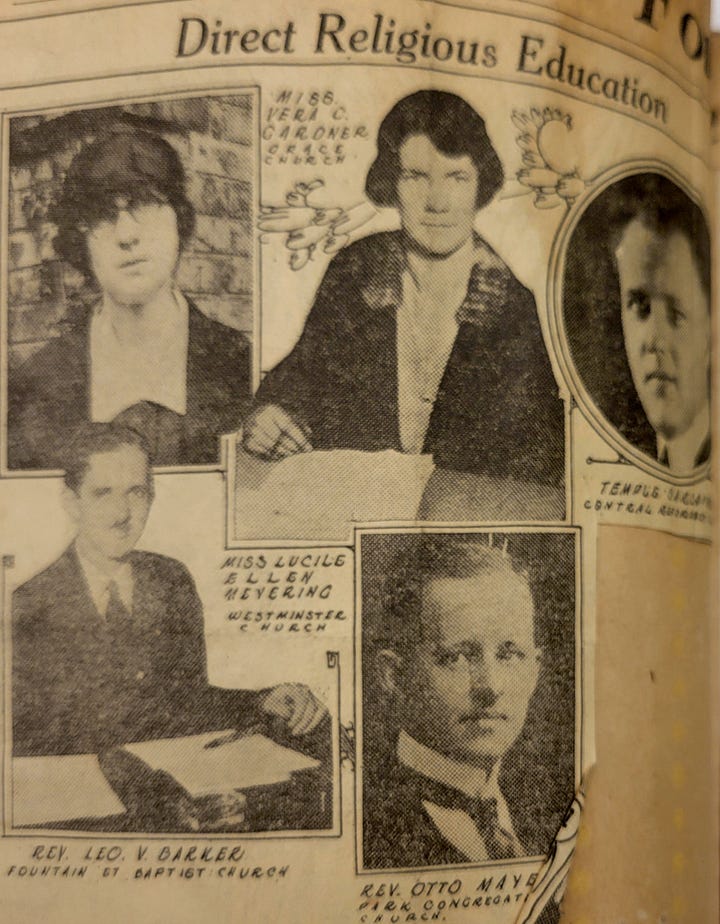
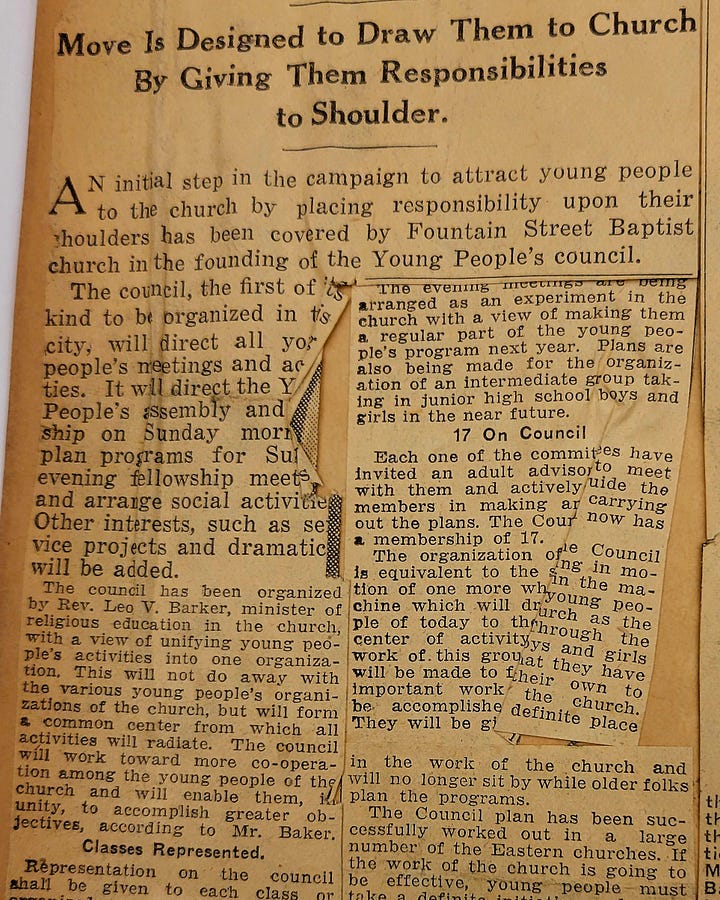
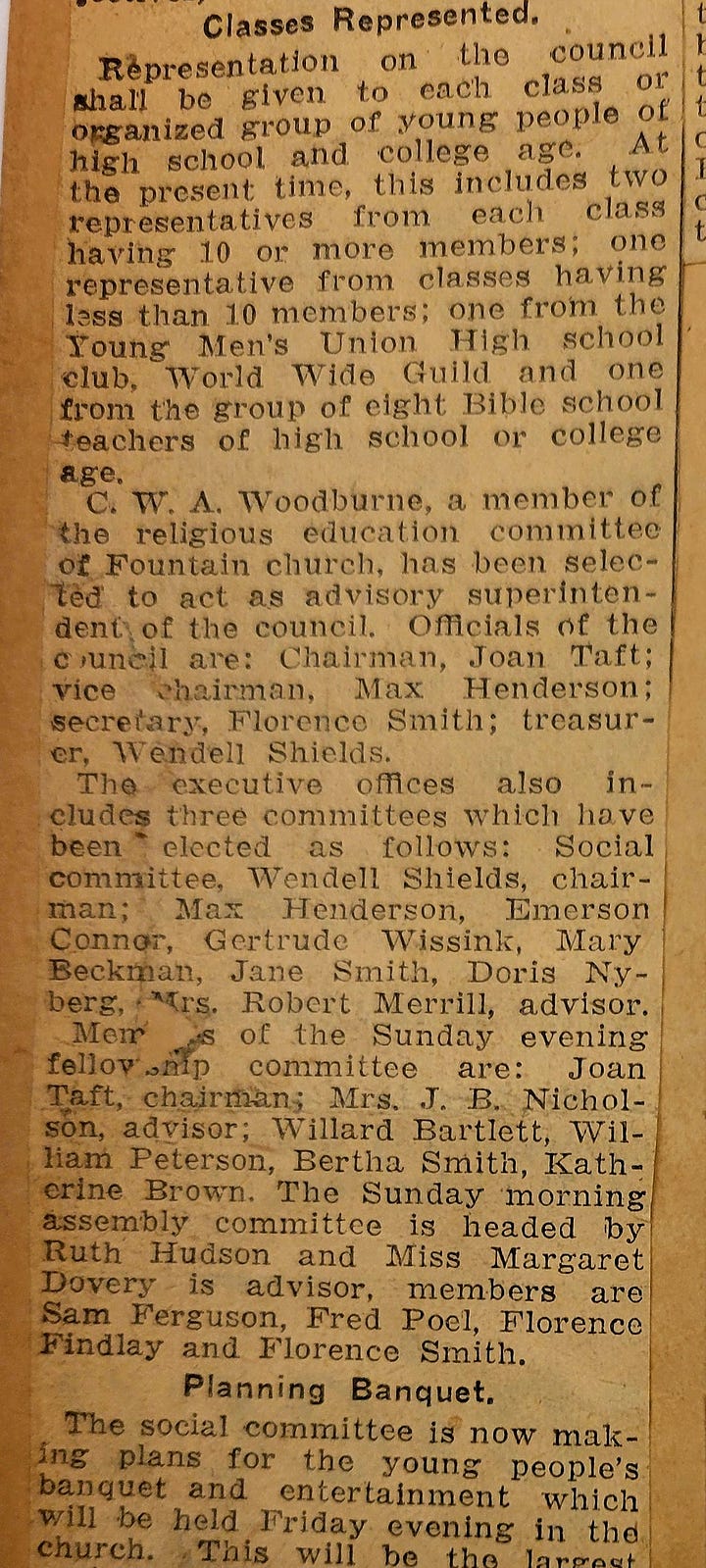
Children’s drama programs go back nearly as far. And the church staff has nearly always included professionals responsible for supporting these programs.
We currently have two staff-members who bring professional talents that lend themselves to this work and I’m heartened to see new life in these areas.
Our Director of Education, Katie Mitchell, could have stepped out of the history of these programs and is a fantastic example of the caliber of educators that take on this occasionally exasperating labor.
Recently, she developed the Graduate Sunday program and assisted in resurrecting the scholarship program. Two of our best and brightest Fountain Clubbers are now heading into adulthood with a $500 scholarship from the church. This was Katie’s work and she deserves the credit. Investing in higher education is a value that is as old as the church itself. I was amazed by the two graduates and I’m honored to be affiliated with a church that bears their association. I wish I had a tenth of their smarts when I meandered off to college.
She’s also recently returned from a long-delayed (unfairly delayed!) excursion with the Fountain Club youths to northern Michigan and Mackinac Island where they did great deeds and acquitted themselves in a fashion befitting their status as Fountain Streeters. Their adventures were legendary. Far too important to be recounted in these pages.
I want to thank Todd and Patty Johnson, who have always been the stalwart backbone of this programming.
This summer, Katie will be launching some new summer programming for kids. We’re not going to use the words “vacation bible school” because it’s not a vacation bible school. It does, however, fill that niche in the ecosystem of summer parenting. I’ve been briefed on the program, it’s phenomenal, and my kids will be attending. I understand that Katie will be adapting the lessons of Humanism to this program. It’s perfect, I love it, we’ve got one of the finest humanist associations in the country now safely calling our campus home, and the pieces are falling into place.
Development on the Character School programming continues apace. We need to purchase a new hearing “loop” - a device that will open our program up to kids with hearing disabilities. This device isn’t cheap - I think it will cost roughly $4k - but it’s required to meet the standards of the O.W.L. program. If you wish to help offset the cost and increase accessibility at FSC you can make a donation here.
We were understaffed in the area of children’s music. This required action. It was by provenance alone that we hired an organist with a tremendous professional background in children’s music education. Noah Smith is a fantastic organist - but we hired him to be the organist. With his support, the Governing Board has now added to his professional portfolio the task of developing and deploying a new roster of children’s music programming. This will include a summer music camp, piano lessons, pipe organ encounters, and the rebirth of the Youth Choral program that will be featured in four worship services during the ‘25-26 program year.
I’ll make a great deal of noise about all of this in the coming weeks.
All of these new programs will require operational support (websites, registration, etc.) and volunteers. You do not need to have a child enrolled in these programs in order to lend a hand. To volunteer, please send an email to nsmith@fountainstreet.org
To financially support this effort (as scholarships will be offered to those in need) please make a gift to the Children’s Music Fund.
I’d like to see us do more to support the Parents Circle at FSC - which will serve more-or-less as the PTO of the church. I’d like to find a way to expand this circle to include our larger circle of educators - teachers, care-givers, and other adults who want to support the next generation.
We have work to do!
In solidarity,
Rev. Nathan Dannison
P.S. I had previously found an incomplete book of Fountain Street recipes in the archives from the late 1800s. I was vexed, as the last pages were missing and they appeared to contain some hilarious joke about husbands. I had the first half of the joke, but the conclusion was missing. This was keeping me up at night.
I found another copy of the book. It was located by an antiquarian dealer in Cambridge, MA. I purchased it and donated it to the church. I transferred it into the loving care of the archivists… right after I scanned the rest of the joke. Without further ado, I present to you the Jackson Circle Cook Book - and “How To Cook Husbands.”




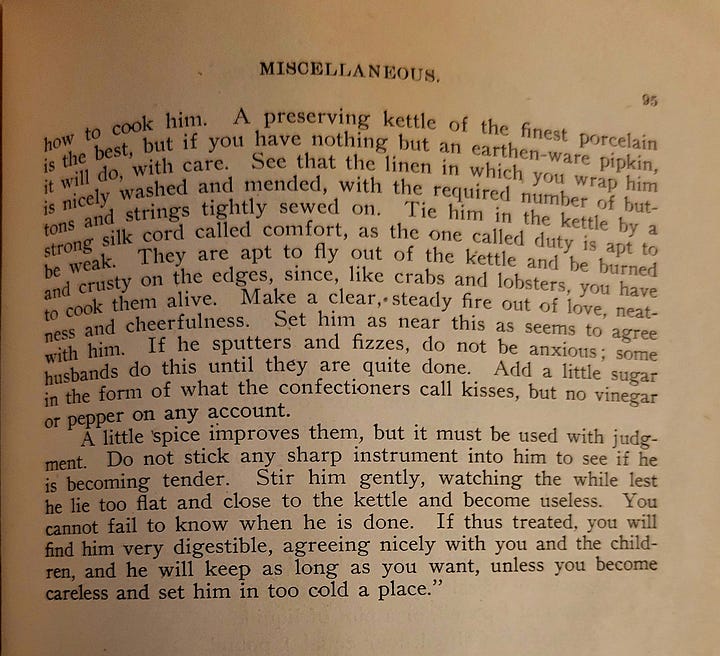




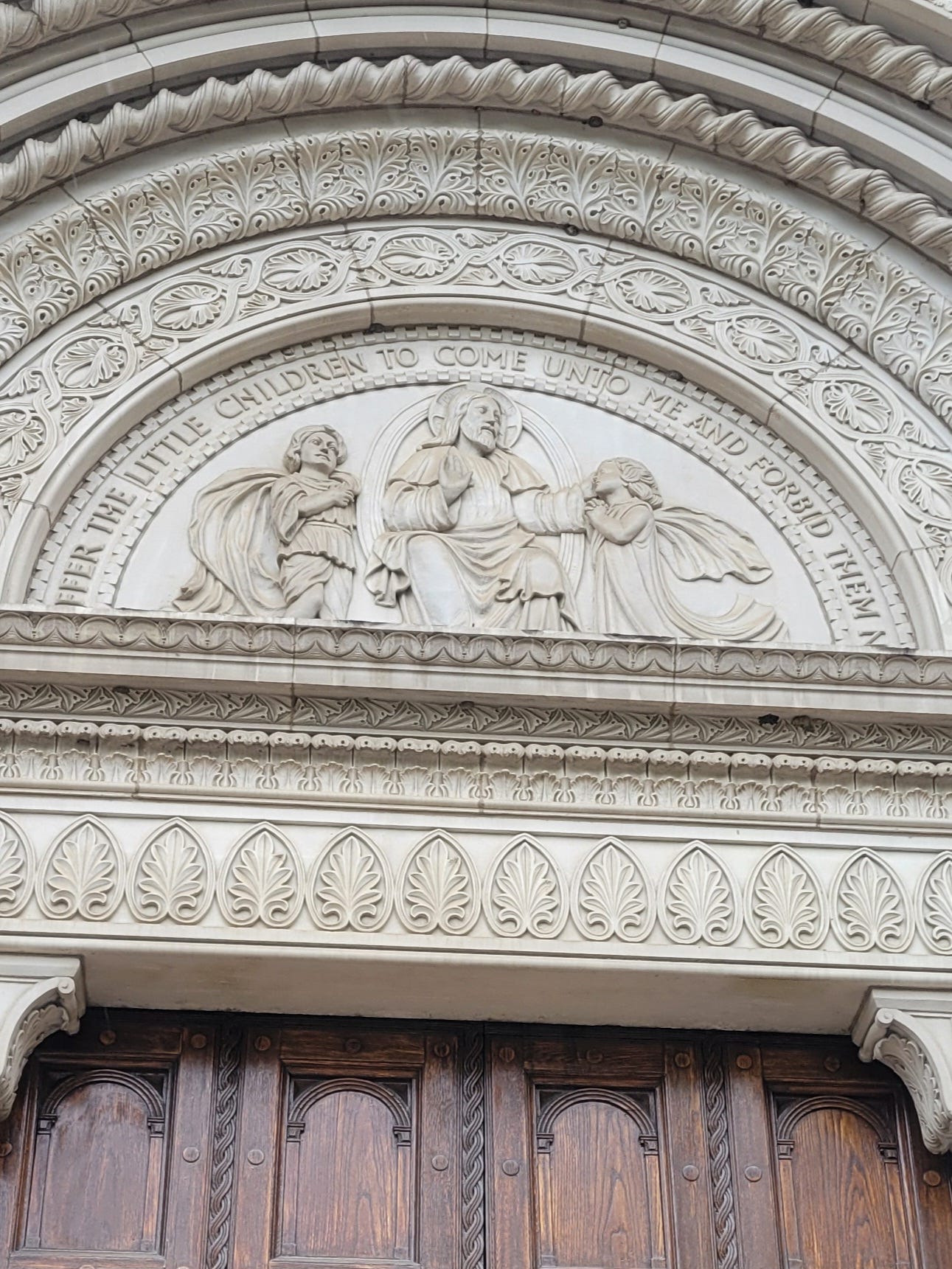
“Tie him to the kettle with a cord of comfort, as the cord of duty is likely to break.” HA!